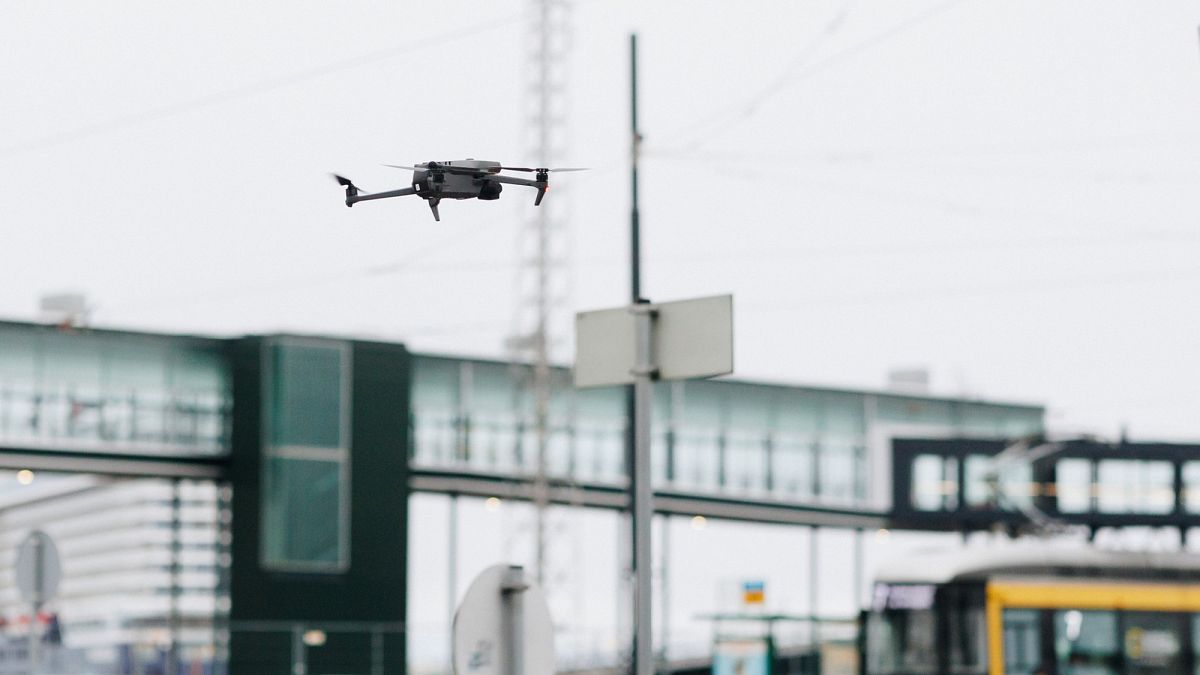Finland’s capital, Helsinki, is turning to drones and artificial intelligence (AI) to help tackle one of the city’s trickiest challenges – keeping traffic moving smoothly.
Helsinki’s West Harbour is Europe’s second busiest port, handling about 6 million ferry passengers annually.
Now, new technology is giving city planners a bird’s-eye view of how that movement unfolds and how it could be improved.
Since 2023, drones have been taking to the skies above the major transport hub, linking ferries, trams, metro lines, and trains.
Drones collect information on passengers’ route choices to improve connections between different modes of transport and reduce peak congestion, according to Forum Virium Helsinki, the city’s innovation company.
“The project is to improve traffic flow with AI solutions and create a basis for more sustainable urban mobility,” Eero Jalo, a project manager at Forum Virium Helsinki, told Euronews Next.
The drones track cars, trams, bicycles, electric scooters, and pedestrians. Each round involved three to six drones capturing video footage of traffic during cruise ship arrivals and departures, when traffic is at its busiest.
Eventually, the data gathered from the drones will feed information on congestion formation and traffic flow into the AI to create simulations.
Privacy questions still hover
The Swiss start-up, Mobilysis, handles the data processing, using AI to detect and classify vehicles and track their movements, such as how fast they’re going, where they’re heading, and how they interact with one another.
“Our data can provide insights on how ferry passengers arrive at the terminal or continue their journeys – whether they board trams or buses, take taxis, walk to nearby parking, or even use scooters and bicycles,” Manos Barmpounakis, Mobilysis’s CEO and co-founder, told Euronews Next.
“These insights are crucial for designing better intermodal connections and making travel through the port area smoother and more sustainable,” Barmpounakis added.
The processed and analysed data are then integrated into AI-powered digital twins, which are “a highly complex virtual model that is the exact counterpart of a physical thing,” according to IBM. That “thing” could be anything from a car or a bridge to a jet engine.
In this case, the digital twin will allow city regulators and engineers to test different traffic management strategies virtually before applying them in the real world, the Helsinki company said.
“This process is crucial for transforming raw video data into actionable insights. That can be used to predict traffic flow, identify congestion and develop more efficient management strategies,” Jalo said.
“The core of the AI function is the simulation…, providing analysis of travel behaviours and their impact on traffic flow,” he added.
Mobilysis said the raw videos are never shared externally – only the “anonymised, AI-processed trajectory data” is used for analysis, and the data collection complies with Europe’s data protection laws.
“The drones are positioned at fixed observation points and record bird’s-eye-view videos of multimodal traffic,” Barmpounakis said.
“This perspective is ideal for understanding how different transport modes interact in busy urban areas. This bird’s-eye-view also allows us to have GDPR compliance, as no faces or license plates are visible,” he added.
Still, some experts warn that even GDPR compliance doesn’t eliminate all privacy concerns.
“What is noteworthy in the case of GDPR-compliant drone surveillance is that the citizens seeing a drone in the sky have no way of knowing whether it collects data in a manner that does not violate rights to privacy and security,” Alina Wernick, a group leader of the Law, AI and Society Group at the University of Tübingen in Germany, told Euronews Next.
She also flagged potential cybersecurity risks and the danger of combining datasets in ways that could, in theory, reveal personal details.
The city said it is keeping residents in the loop.
“There have been many questions [from the citizens],” Jalo said.
“We are sharing this information on what happens in our test areas with drones. It always generates good interest from citizens. And also how to use them, we keep this open and develop how to share this information for the citizens,” he explained.
EU-funded project
The pilot project will test how “soft measures” such as route recommendations or incentives to travel at off-peak times can help improve city-wide traffic flow. It also aims to explore how new technology can support climate goals by encouraging more sustainable journeys.
It will also trial an app that offers alternative modes or routes to test users, based on the simulation data.
The ACUMEN project, short for AI-aided decision tool for seamless multimodal network and traffic management, is funded by the European Union’s Horizon Europe research and innovation programme.
It’s led by the Aalto University in Finland and brings together eight EU countries as well as Switzerland. Similar trials are underway in Athens, Amsterdam, and Luxembourg.
Helsinki’s final toolkit and policy recommendations are expected in May 2026, when the ACUMEN project wraps up.
While this could pave the way for AI-guided traffic management across Europe, some experts argue that the right to security should carry more weight when assessing the impact of such projects.
“On one hand, digital twin technologies, which are used for simulations and mentioned in connection with ACUMEN, are criticised for being unable to provide accurate representations of the complexity of a city,” Wernick said.
She added that collecting more precise data may help the municipality to fulfil citizens’ human rights, or to ensure that the digital model accounts for the more diverse needs of citizens.
“On the other hand, the public perception of certain technologies may change, as in the case of the use of drones in the city environment”.
For more on this story, watch the video in the media player above.

